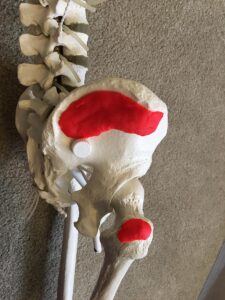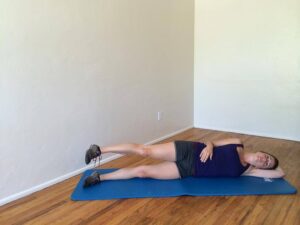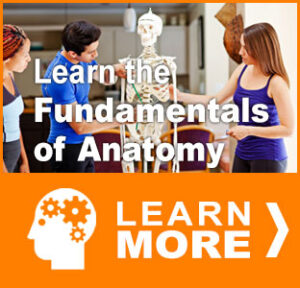Everybody knows the “glutes” are the largest muscle in the body. BUTT…they’re not just one muscle. In total, your glutes incude three muscles that each have 2-3 sections. In total, you have eight glutes (nickname for gluteals).
The three glutes
Gluteus Maximus – 3
Gluteus Medius – 3
Gluteus Minimus – 2
In this article you’ll learn about gluteus medius and how it’s an antagonist to itself. Just like the name says, it’s in the middle of the other two glutes if you think about them as layers. Gluteus maximus is most superficial (closest to surface) and gluteus minimus is most deep (closest to bones).
Gluteus Medius Attachments
All three parts of your gluteus medius attach to the superior (top) of the greater trochanter on your femur. This chunk of bone is fairly easy to feel because it’s close to the skin. You can locate it on yourself by standing, placing your hand on the top of your outer thigh and rotating your femur to feel it moving back and forth.
The three parts of gluteus medius divert from the greater trochanter to different places on the iliac crest, which is the ridge of your hip bone. They create a fanned appearance.
The first section travels to the anterior (front) of this ridge.
The second section attaches to the middle of this ridge.
The third section goes to the posterior (back) of this ridge.

Gluteus Medius Function
“Think like a muscle” is what I tell anatomy students when they’re trying to remember muscle actions. Look at the attachments, they reveal the role of the muscle and remove the need to memorize the many actions.
Remember…
- Muscles contract (shorten) when lengthened to keep the bones together.
- Muscles contract (shorten) to move bones when signaled by the brain.
Find the attachments on your body using your fingers to locate the bony landmarks you see in the photo. Enhance your body awareness by getting familiar with where the muscle “lives”. Move your hip into abduction (to the side) to feel the attachments contract into your fingers.
What motions would cause the gluteus medius muscle to shorten OR lengthen?
Gluteus Medius Movements
- Abduction. Most people are familiar with this action for gluteus medius. As humans we don’t directly do this action during normal walking. It would look funny and cause us to move like a crab, walking sideways. As we walk, gluteus medius monitors hip movement as it goes into flexion and extension. It helps keep the hip on track.
- Flexion AND Extension. Say WHAT!?!? How can a muscle do opposing motions? This is because gluteus medius is three different muscles in one. The anterior (front) portion can influence hip flexion while the posterior (rear) portion can create hip extension.
- Internal AND External rotation. There it is again, opposing actions. Anterior glute med causing internal and posterior glute med causing external rotation. You’ll see why this matters in the next section…
Gluteus Medius Exercises
You may be familiar with these exercises, but now you can do them more effectively and avoid compensating with the surrounding muscles like obliques. Many people over-use their spine, but now that you know the attachments better you can monitor the movement more effectively on yourself and clients.
- Leg lifts.
Lying on your side and abducting (lifting) your leg is one of the most popular ways to strengthen this muscle.Stop when you feel your spine moving a lot, probably at about 30 degrees.
- Band walks. A stretchy band around the ankles or thighs provides resistance while you move sideways like a crab. Keep your torso stable and relax your shoulders.
- Mix it up. Slightly flexing or extending and slightly internally or externally rotating your femur will change which section of the gluteus medius is contracting. Give it a try and tune in to the different sensations as you change positions.
Connect to the Gluteus Medius
When you exercise, think about the attachments of the muscle. Visualize it shortening and lengthening. Do this by going more slowly through the motions. You’ll get more out of the time you spend strength training.
LEARN MORE ANATOMY WITH US – AND GET CECs TOWARDS TRAINER RECERTIFICATION!
References:
Abrahams, P.H. et al. 2003. McMinn’s Color Atlas of Human Anatomy. London: Elseiver.
Muscolino, Joseph E. 2004. Musculoskeletal Anatomy Coloring Book. Philadelphia, PA: Mosby, Inc.





